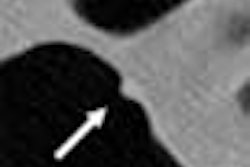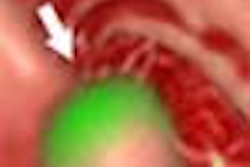SAN FRANCISCO - North American healthcare facilities have moved decisively away from ultrasound and toward CT for the evaluation of suspected acute appendicitis in children, with the choice of modality varying significantly from one region to the next.
Between 2000 and 2002, the roughly 60/40 split in favor of ultrasound has been flipped on its head, according to Dr. Kimberly Applegate from the Riley Hospital for Children in Indianapolis. On behalf of study authors by Greg Titus and Brandy Reed, Applegate presented the results of a practice survey of Society for Pediatric Radiology members on Thursday at the organization's annual meeting.
"We had noticed a lot of variability in the literature and in individual anecdotal reports about who is using CT and ultrasound, or a combination of those, and also how often plain radiography continues to be used," Applegate said. "When we asked (in 2000) what is the dominant imaging technique used to screen children (with) clinically suspected appendicitis, the split was about 60/40, with more people using ultrasound, and we were interested in seeing if that had changed in two years. We also wanted to look at geographical variation in the use of these imaging modalities and in the techniques reported."
The respondents represented 126 children's hospitals or healthcare centers that are fairly evenly distributed throughout the U.S., as well as three centers in Canada, Applegate said. All but six of the respondents in 2002 had also completed the 2000 survey.
"In 2000, 36% said CT was the primary modality, and 64% said ultrasound was their primary imaging modality," she said. "Whereas in 2002, 56% responded that CT was their primary imaging modality and 44% said ultrasound" (P=0.001).
There were also surprising discrepancies between regions. CT use was highest in the Midwest, at 70%, and lowest in California, at 36%. Canada's three centers sided with California. The Northeast and Pacific Northwest split the difference at 50% CT use, 50% ultrasound, while the Southwest used CT 37% of the time, and the Southeast used it 58% of the time.
"In Canada both in 2000 and in 2002, the predominant response was by far to continue using ultrasound instead of CT except for difficult cases," Applegate said.
The researchers also wondered if centers had a standard CT protocol for imaging children with suspected appendicitis. After all, in 2000 they had reported a total of 14 different CT techniques, which dropped to 10 in the current survey.
In all, 79% of respondents reported using both oral and intravenous contrast for CT, and imaging that covered both the abdomen and the pelvis. In 2000 just 69% reported using that technique.
"Ten percent of participants reported no IV contrast use -- that's down from 2000," Applegate said. "Twenty-six percent use no GI contrast, either oral or rectal, and that's up from 2000. Eighteen percent use rectal contrast -- that's slightly up from the prior survey (11%)."
The vast majority of respondents, 83%, use thin collimation of 5 mm or less in CT. Unfortunately, only 10% were able to report explicit mA settings in their parameters for these children, and 54% were unable to recall the complete CT protocol. Forty-five percent said they used an age- and weight-based scale, while several reported using the "Lane Donnelly Technique," or the "Duke Technique," Applegate said. The CT technique also differed somewhat between male and female patients.
About half of the interpretation was performed by the attending radiologist, the other half by residents or fellows.
"In terms of abdominal radiography, it has dropped a little bit from 2000," she said. "In estimating the number of children who receive abdominal radiography for the workup of suspected appendicitis, 56% of children receive the radiographs and that hasn't changed, but 44% of members doubt their utility."
CT has rapidly become the primary imaging test for acute appendicitis in children, she concluded. And while CT protocols have become more standardized, there are persistent geographic variations, both in the use of imaging modalities and in CT techniques.
Asked if there were any ostensible reasons for the different practices by region, Applegate said there are several factors at play.
"I think the answer to geographic variation is related to training, it's related to how well we're trained in the technique, what the referral pattern is, and the availability of nighttime or 24/7 ultrasound techs," she said. "I think it also reflects a real trend in staff shortages: We don't need to be in the hospital to interpret CT from home."
By Eric Barnes
AuntMinnie.com
staff writer
May 9, 2003
Related Reading
US
plus CT improves pediatric appendicitis management, March 25, 2003
CT
highlights neoplasm in secondary appendicitis, December 10, 2002
Imaging
technologies reduce unnecessary appendectomies in children, December 13,
2001
Ultrasound
differentiates causes of abdominal pain in kids, October 4, 2002
Ultrasound
superior to clinical impression in diagnosing acute appendicitis, October 23,
2001
Copyright © 2003 AuntMinnie.com



















